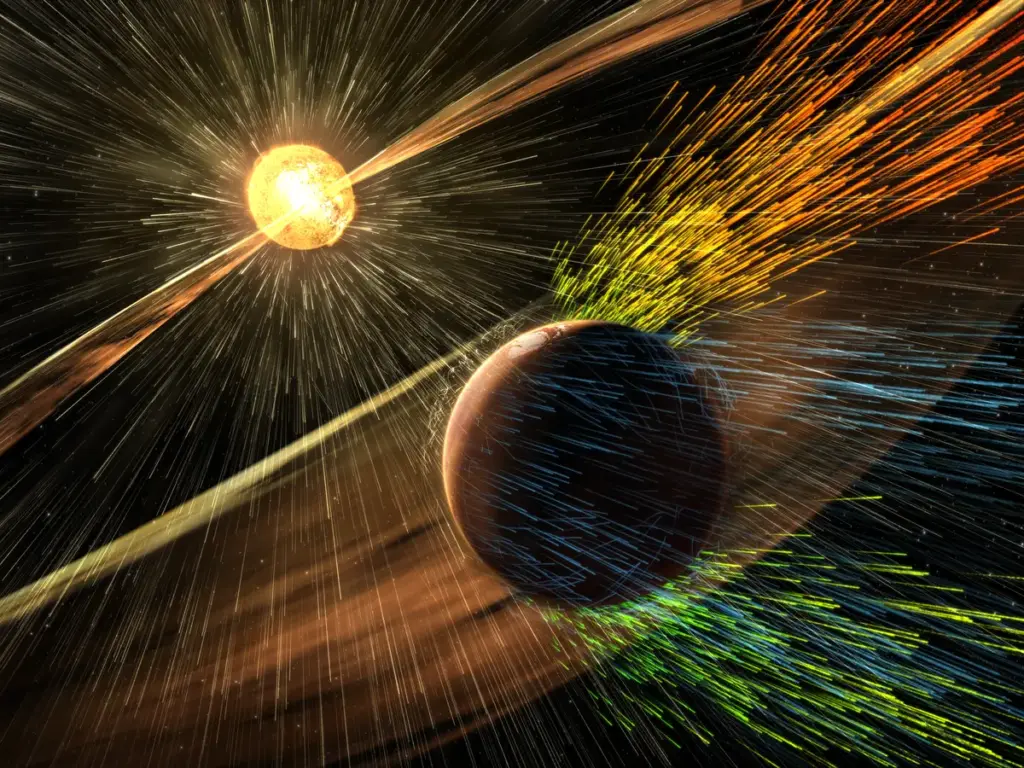
Solar storms, driven by the Sun’s activity, pose significant risks to future astronauts on Mars. Unlike Earth, Mars lacks a protective magnetic field and thick atmosphere, leaving its surface exposed to high levels of solar and cosmic radiation. This exposure can lead to serious health issues, including increased cancer risk, cardiovascular problems, and potential damage to the nervous system. Understanding and mitigating these risks is crucial for the safety of crewed missions to the Red Planet.
NASA’s Mars Atmosphere and Volatile Evolution (MAVEN) orbiter and the Curiosity rover play pivotal roles in studying Mars’ radiation environment. MAVEN, operating in orbit, detects solar flares and coronal mass ejections, providing early warnings of increased radiation levels. Meanwhile, Curiosity’s Radiation Assessment Detector (RAD) measures the radiation reaching the Martian surface, offering data on the potential exposure astronauts might face. Together, these missions provide a comprehensive understanding of the radiation hazards on Mars.
Insights from Recent Solar Storms
In May 2024, a significant solar storm struck Mars, offering valuable insights into the planet’s radiation environment. MAVEN observed auroras across Mars’ night side, indicating the interaction of solar particles with the Martian atmosphere. Simultaneously, Curiosity detected a surge in radiation levels at the surface, highlighting the potential hazards to astronauts during such events. This incident underscores the need for robust radiation protection strategies for future missions.
The primary concern for astronauts on Mars is the high levels of radiation they would be exposed to. Without Earth’s protective magnetic field and atmosphere, Mars offers no shielding from solar and cosmic radiation. This exposure can lead to acute health effects, including radiation sickness, and increase the long-term risk of cancer and other serious health conditions. Therefore, understanding and mitigating these radiation risks is essential for the safety of Mars colonists.
Strategies for Radiation Protection
To protect astronauts from harmful radiation, several strategies are being considered. One approach is to utilize the Martian terrain itself, such as lava tubes or underground habitats, which can provide natural shielding. Additionally, spacecraft and habitats may be equipped with materials designed to absorb or deflect radiation. Ongoing research aims to develop effective materials and technologies to safeguard astronauts during their missions on Mars.
Monitoring space weather is crucial for predicting solar storms and other events that could impact Mars missions. NASA’s recent launch of the Interstellar Mapping and Acceleration Probe (IMAP) and other space weather satellites aims to provide real-time data on solar activity. These missions will enhance our ability to forecast solar storms and implement timely protective measures for astronauts on Mars.
Looking Ahead: Ensuring Safety on Mars
As plans for crewed missions to Mars progress, addressing the challenges posed by solar storms is a priority. Through continuous monitoring, research, and the development of protective technologies, NASA and international space agencies aim to ensure the safety and success of future Mars missions.
According to Dr. Sarah Johnson, a planetary scientist at Johns Hopkins University, “Understanding the radiation environment on Mars is crucial for the success of human exploration. We must develop innovative solutions to protect astronauts from the harsh conditions they will face.”
By the Numbers: Solar storms can increase radiation levels on Mars by more than 50 times the normal background levels, posing significant risks to human health.
The announcement comes as international collaboration in space exploration continues to grow. Countries like China and the European Union are also investing in technologies to address the radiation challenge on Mars, highlighting the global effort to make human settlement on the Red Planet a reality.
The move represents a significant step forward in ensuring the safety of astronauts as humanity pushes the boundaries of space exploration. With advancements in technology and a deeper understanding of space weather, the dream of establishing a human presence on Mars becomes increasingly attainable.






